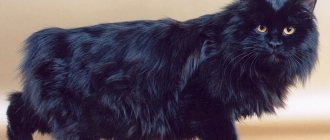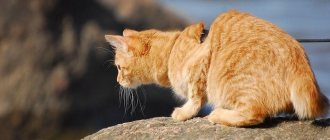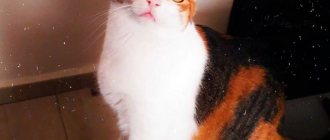The Mekong Bobtail is a relatively young breed of cat, bred primarily by Russian breeders. The breed is visually and historically related to the more famous Siamese cats, but has a number of differences. The most striking individual feature is taillessness, or rather, they have a tail, only it is very short and necessarily has kinks, due to which a characteristic curl appears. With bright blue eyes and a friendly disposition, these Siamese cats are an excellent choice for any family.
Origin story
The Mekong Bobtail is both a new and a very ancient oriental cat breed. A manuscript depicting a Siamese-type cat dates back to the 14th century and is kept in the Bangkok Museum, meanwhile, the breed was officially approved only in 2004, but first things first.
There are many legends associated with Siamese cats in their historical homeland. One of them says that for many centuries, animals with blue eyes and dark faces lived in palaces, guarding treasures and accompanying princesses on walks. A special role was given to cats with curled tails. While swimming, the girls took off their jewelry and hung it on their tails; due to their special structure, rings and earrings did not fall to the floor and were not lost.
The history of the development of the Mekong Bobtail breed is closely connected with the origin of Siamese and Thai cats. For the first time, native cats from Siam came to Europe at the end of the 19th century. In 1884, they were brought to England by an official of the British consulate in Bangkok, Suen Good. The ambassador claimed that the king of the overseas state himself gave him the pair. Around the same time, the first cats arrived in America, traveling from modern Thailand across the ocean to the New World. Many of these animals had kinks and hooks on their tails, which were a sign of royal cats, but breeding work followed the path of culling animals with “flaws.” Perhaps this distinctive feature and separate breed would have been lost if not for the enthusiasts (in particular from Russia) who have been supporting the population for many years.
In addition to those first Siamese, many more bobtails were exported from the countries of Southeast Asia. Short-tailed purrs are a common sight there. In general, the modern name emphasizes their origin Mekong - a long river of the Indo-Chinese peninsula that flows through different countries:
- Burma;
- Laos;
- Vietnam;
- Cambodia;
- part of China and Thailand.
The ancestors of many modern lines were brought from these countries.
In the process of working on the breed, breeders had to add animals with short tails of unknown origin to the breeding, but they first underwent strict selection. There is an opinion that Thai cats with creases on their tails took part in the breeding of the Mekong, but large clubs claim that such matings were not done because they were unjustified. The kittens born as a result of such crossing did not correspond to the given type at all. Today, any interbreed matings for Mekong Bobtails are prohibited.
The first standard for the Thai Bobtail breed (that’s what the Mekong was previously called) was developed by a breeder from St. Petersburg, Olga Sergeevna Mironova. Thanks to her many years of work, it was approved at a seminar of felinologist experts on indigenous cat breeds in December 1994 and was only slightly adjusted at a meeting of the board of felinologist experts in Moscow in 1998.
The presentation of the breed took place in 2003 at the International Exhibition, which was organized by Royal Canin. 30 animals from different breeding lines were presented. A year later, the name was changed to Mekong Bobtail to avoid confusion with the Thais.
Today, more than 300 Mekongs are registered by clubs in Russia, Latvia, Belarus, Germany and Poland. The bulk of the livestock is located in Russia, in particular in the Korgorushi club. Other well-known clubs of this breed include:
- Bast (Kursk);
- Kotofey (St. Petersburg);
- Triumph (Tver);
- Aurinko (Petrozavodsk).
Little-known facts about the breed
It has been reliably proven that these cats served not only as stands for rings and bracelets, they also performed the important function of snake hunters, protecting the territory from creeping reptiles, of which there are simply enormous numbers in Asia.
The skin of true Thais is very flexible and when pulled back does not cause any discomfort to the cat, because... it does not adhere tightly to the muscle tissue, which means there are very few nerve and blood vessels there. When a snake bites, the poison does not spread instantly; the cat has time to finish off the enemy and find medicinal herbs. In any case, the mortality rate from snake venom among Thais is indeed extremely low. And this, you see, is another “magical” ability of short-tailed purrs.
This ability allowed the Thais to consider their cat as the personification of the deity who accompanies the souls of the dead to another world and back.
If we put together all the legends and myths about the Thai Mekongs, it becomes clear why these cats with “rabbit” tails were and remain obligatory participants in many religious ceremonies. In Thailand, they even celebrate a special cat festival dedicated to the Buddhist cat, and celebrate it on November 12 according to the European calendar.
The Thai or Mekong Bobtail has been known for over 600 years.
There is even a mention of a strange cat with a short, crooked tail in the biography of Khan Babur (Babur Zahireddin-Muhamed 1483-1530) - “Babur-name,” his autobiography, written by this Uzbek and Indian ruler of the Mughal state with his own hand. Considering that this man is not only a famous commander, but also a politician and public figure of his time, descended from Timur and Genghis himself, I think his words can be trusted 100% when he writes that he received a gift from the hands of Emperor of Siam an amazing “golden kitten” as a token of gratitude for some kind of paramilitary assistance.
Having received the blue-eyed miracle as a gift, Khan Babur quickly understood from the character of the animal why the Mekong bobtail is called “living gold” and appreciated the justice of this name, but the khan never managed to receive a second kitten of the opposite sex.
Attempts to steal and take a Siamese bobtail outside the state without special imperial permission were not punishable by a quick and painless death.
Appearance and standards
Mekongs are unique, short-haired, medium-sized point cats with an elegant build and a short tail in the form of a tassel or pom-pom. Males are much larger and more powerful than cats, weighing on average 3.5-4 kg, while cats weigh no more than 2.5-3 kg.
Head and muzzle
The cats' head is smoothly contoured, almost flat on top. The oval shape of the muzzle is emphasized by the heavy lower jaw and chin. The ears are laid back slightly, set high, wide at the base with slightly rounded tips. The eyes are large and expressive. A characteristic feature is a more rounded lower eyelid, which indicates a close relationship with other Thai cats. In general, the cut can be called slightly slanting. Only one color is allowed - intense blue.
Body
Mekong has a strong, muscular and at the same time graceful body of medium size. His back is straight and slightly arched towards the croup. Cats have long legs with soft, oval-shaped pads. A notable feature of appearance, in addition to the tail, is that the claws on the hind legs do not retract completely, therefore, if the cat walks on a hard surface, for example, on laminate, a specific clicking sound is heard when walking, which is not typical for cats of other breeds.
Tail
The tail is short and broken, its length is at least three vertebrae, but should not exceed ¼ of the body length. The first break should be at the base of the tail. Externally, the creases may not be visible, but they must be felt through the skin. The bobtail tail is not only a distinctive feature of the breed, but also a kind of “passport” of each animal, because no two tails are identical. Each one is unique in its own way with unique curves, kinks and lengths. By the way, there are no long-tailed Mekongs.
Coat and colors
The soft, short fur lies tightly to the body. It is beautiful and shiny, pleasant to the touch with minimal undercoat. This type of fur is often compared to mink. Another feature of the Mekong is that its skin does not adhere firmly to the muscles and is pulled much stronger than that of other cats, not only at the withers, but almost throughout the body.
For Mekong Bobtails, any point (Siamese) colors without white spots or markings are allowed. The most common:
- blue point;
- tabby point;
- red point;
- tabby point.
Suit
For the Mekong, seal point is considered a classic color. It is the most stable of its type. The following colors are allowed: tortie and tabby varieties, cream, blue, chocolate, red, lilac, lynx. Breeders are working to develop lilac and gold shades.
The most common colors:
- Seal-point. The general background is cream, the mask and markings on the paws are black.
- Red-point. Rare color. Against the background of snow-white skin there is a fiery red mask and “gloves”. The main white color may slightly shimmer with a peach tint.
- Tortie-point. Nature rewards only cats with this tortoiseshell “outfit.”
- Blue-point. The body is covered with silver hair, the mask and the color of the legs are bluish or pink. Quite a rare color.
- Chocolite-point. The general background is cream or snow-white, the markings are chocolate-colored. The peculiarity of this suit is the lilac or purple tint of the eyes of animals.
- Tabby-point. On a white or lightly tinted background with tabby markings and a variety of lace patterns. A prerequisite is the presence of a mark in the form of the letter “M” on the muzzle. The accuracy and clarity of the drawing is valued.
Character
Mekong Bobtail cats are distinguished by their balanced temperament and special intelligence; they are friendly and sociable. Very often they are compared to dogs. And indeed these two animals have a lot in common in behavior. Mekongs walk calmly on a leash, are smart enough to remember house rules and simple commands, love to carry different things in their teeth and fetch objects, they constantly accompany their owners, use their teeth rather than claws in fights, and express their range of emotions with their tail.
Like many other representatives of the eastern group, they are quite talkative, but unobtrusive. With all its appearance and habits, the Mekong shows that it belongs to the high society of cats of blue blood - they are proud, stately and independent.
The Mekong Bobtail is equally suitable for large and small families, as well as single people.
You can safely take such cats with you on a trip or for a walk, without worrying about them getting lost. Pets prefer to be close to their owner. In addition, cats treat small children well and endure many manifestations of children's love with angelic patience. Mekongs usually get along well with other animals in the house and never create conflict situations.
Peculiarities
In the cat kingdom, each breed has its own flavor and unique characteristics:
- The most striking feature of the Mekong Bobtail breed is its tails. It is almost impossible to find individuals with two identical tails, exactly repeating the creases and sizes.
- The Mekongs are distinguished by their life expectancy - up to 25 years. With good care and maintenance, a cat can give birth to kittens even at 21 years of age. The officially registered life record is 38 years.
- The claws on the hind legs do not retract completely. When walking on a hard surface (wood, laminate), they make a characteristic clicking sound, reminiscent of a dog walking.
- This breed has absolute matriarchy. The Mekong Bobtail cat controls not only the offspring, but also the cats. They humbly accept her dominance, never allow themselves to snap at a slap from a lady, and patiently endure all “instructions.”
- When it's hot, the pads of your paws are the first to start sweating.
- Cats do not tolerate loud noise well; they try to leave the discomfort zone.
- In a fight, the teeth are the first to be used as weapons, and only then the claws.
- Children are raised by their “dad,” which is quite a rare occurrence in the animal world.
- These cats use their voice exclusively to communicate with people.
- The skin does not adhere tightly to the muscles, a large gap allows the animal to endure children's hugs painlessly.
Content
Mekong Bobtails are great for apartment living. They calmly tolerate loneliness, practically do not shed, are clean and tidy, without a specific smell. Adult cats very rarely mark corners. Perhaps little kittens will cause a little trouble with their irrepressible energy and activity, but as they grow older they will become more serious and balanced, but by no means lazy.
Mekongs reach puberty very early, many by 4-5 months. It is important for owners of several cats not to miss this moment and to prevent accidental matings of young and fragile animals.
Mekong Bobtail cats retain their sexual activity until old age. It’s interesting that when kittens are born, cats take over the mother’s function, that is, they lick the babies, teach them to use the toilet, feed them, etc. So, if you have a pair of Mekong Bobtails, then matriarchy will reign in your home. The cat, in turn, takes upon itself only one responsibility - to feed, and carefully ensure that “dad” fulfills all his upbringing responsibilities. In addition, representatives of the “female half” behave more independently, and in their behavior strongly resemble an eastern princess.
Care
Representatives of this breed do not require special care. It is enough to comb them 3-4 times a month to remove dead hairs. Brush a little more often during the molting period and only in order to reduce the number of hairs left on things or furniture. It is not recommended to bathe the Mekong often. Many owners resort to water treatments only before exhibitions.
The ears are periodically inspected and, if necessary, cleaned with a special lotion. As a rule, there is no need to clean the eyes. Cats wash themselves on time and are not prone to excessive tearing, and therefore their tear ducts remain clean without owner intervention.
Diet
Each cat is individual, this must be taken into account when deciding the issue of feeding. Animals that are not picky can be fed natural food, providing them with a complete diet, in which, in addition to meat and offal, 15-20% should be cereals and vegetables. Once a week you can give fish and a quail egg. It is not recommended to feed cats “from the table”.
Remember that milk is only beneficial for kittens up to 2-3 months old. With age, the ability to digest lactose decreases markedly, and sometimes disappears altogether.
If for some reason it is impossible to organize a balanced natural diet, you should give preference to ready-made food. It is worth considering that this must be complete food of at least premium class. Also, when choosing food, it is important to take into account the physiological characteristics of the animal:
- age;
- pregnancy period;
- lactation and so on.
Feeding
The Mekong Bobtail is a breed that is not particularly picky about food. Cats live quietly on ready-made food and homemade food. They feed twice a day. Access to clean water at room temperature should be constant. Animals prefer to drink from deep containers. When choosing industrial feed, you should choose high-quality premium products. It is difficult to overfeed Mekongs; they are not greedy for food and do not suffer from obesity.
When feeding natural products, you need to remember a few rules:
- Do not give milk, fatty meat and fish;
- all natural products, regardless of origin (meat, dairy) cannot contain more than 10% fat;
- meat products must be fresh;
- pork and liver are contraindicated for bobtails;
- river fish is allowed only in boiled form;
- pollock and cod are not welcome in the diet;
- food containing a lot of copper and magnesium leads to dullness and darkening of the coat color;
- It is not recommended to give beets and cabbage as vegetables.
Vegetables are grated and mixed with fish or meat. Animals eat cottage cheese, eggs, kefir, meat, offal, vegetables and fruits well.
Health and life expectancy
The Mekong Bobtail is a native breed, so its representatives enjoy excellent health. But this does not mean that they do not need to be shown to doctors for a preventive examination, vaccinated and periodically driven away from parasites.
There are a lot of cat diseases that Mekong cats can contract at any time. Monitor their behavior, and if you think that your pet is behaving strangely, is starting to feel sad, or is refusing to eat, be sure to show it to a specialist. Remember that any disease is best treated at the initial stage.
Mekong Bobtails are rightfully considered to be long-lived; for them, 20 years is not the limit. Interestingly, until old age they remain sexually active and are capable of childbearing. For example, the cat from the Korgorushi cattery Mars is a real sex symbol of the cat world; he became a father the last time when he was 23! And a cat from the same cattery named Conchitta gave birth to a litter at the age of 22!
Choice of kitten and price
If you are thinking about buying a kitten of this breed, then first of all you need to decide on a nursery and read reviews about certain breeders. The breed is not the most common, and therefore kittens may have to wait a little and be booked in advance.
Mekong babies will be ready to move to a new home only at three months. It is worth considering that they are born almost white. Characteristic darkening in certain areas of the body begins to appear only from two to three months and is finally formed by the age of one, and sometimes later. Kittens must be healthy and well-groomed, with shiny fur, clear eyes and an excellent appetite.
The average cost of a Mekong Bobtail kitten is 15-20 thousand rubles.
The following factors influence the final cost:
- appearance of the kitten;
- place of purchase;
- availability of documentation.
If you are not sure that you can choose a good baby on your own, it is better to seek help from a breed specialist.
You can often find more affordable options on the Internet. As a rule, “hands-on” kittens without documents cost much less, about 5 thousand rubles.
Mating of Mekong Bobtail
Like any oriental cat, the Mekong is characterized by early puberty and special sexuality. Therefore, you should not be surprised when a little six-month-old bobtail girl suddenly goes into heat.
Of course, at this age the cat is not yet ready to become a mother; technically this is possible, but the offspring from a young mother are unlikely to be viable. Indeed, physically, the pet itself is still a kitten, and physical maturation and puberty are two different things.
Felinologists recommend waiting up to 10 months to mate. By this point, the animal’s body will have matured, and the cat will be ready to give birth to full-fledged offspring without risk or complications for its health and the life of the kittens.
Cases vary, sometimes the Mekong Bobtail can be mated at a younger age - 7-8 months. This is necessary if the cat has early, recurring heats. In such cases, pregnancy is necessary to maintain the health of the animal. But in any case, preliminary consultation with a veterinarian and agreement with the club are required.
In standard situations, one or two heats are missed, but no more than three, because a long delay is another threat to the health of the pet. You should not abuse drugs that stop or suppress estrus. If they are used frequently, the effectiveness of the drug decreases. In addition, hormonal disruptions begin in the animal’s body, as a result the cat can become seriously ill.
Mekong Bobtail – owner reviews
Who can you trust to judge the breed if not the owners and connoisseurs of the Mekong Bobtail? For many people thinking about choosing a pet, reviews of cats are of great importance in making the final purchasing decision.
Personally, I think the Mekong is an excellent breed, and the reviews I picked up were positive (in principle, there were no very negative ones).
- Olga. Korolev.
We have known bobtails for a long time. My son turned 10 when we bought our first cat. How we loved her, and how she loved us. She followed us and slept next to us. Now my son is 25 and recently he bought a copy of our first Sonechka. It feels like Sonya has returned, just as affectionate, purring at her side, lying next to her. Do you know how she feels when she’s bad, she understands everything, we adore her. She recently gave birth, she has four kittens, she is caring, and now everything revolves around them.
- Marina. Saint Petersburg.
I bought the bobtail purely for myself, not for divorce. In fact, I even saved money on this. What can I say - smart, sociable, intelligent. So I adore him, but sometimes his loudness is out of place, but otherwise everything is fine.
These were reviews of the Mekong Bobtail breed. Maybe they will to some extent help you make a decision about buying a pet of this breed or, on the contrary, will make you think about your future choice. The point of publishing reviews is not to highlight the pros and cons of bobtails. The main thing is that people are interested in these cats and are ready to share their attitude towards them, which means that the breed definitely has a future.
Dispersal of the rock
In the 19th century a couple of dozen specially selected super-pedigreed Thai Mekongs were presented as a gift to titled persons of Europe, America and Great Britain, as an amazing, most valuable gift. But only Queen Victoria was able to appreciate the truly great gift, who almost instantly became an ardent fan of the Thai cat, and the Mekong Bobtail at her court received truly royal privileges.
In 1872 in England, at the London cat show, the Mekong Thai short-tailed cat, which belonged to the de facto Queen of the United Kingdom of Great Britain and Ireland, the Empress of India, daughter of Edward Augustus, Duke of Kent, son of George III, Alexandrina Victoria, was shown for the first time.
You will find it funny, but it was under these titles that for the first time in the history of England, a cat of the Siamese Royal Thai Mekong breed was exhibited.
United Kingdom of Great Britain and Ireland, Empress of India, Prince Edward, Duke of Kent and Strathearn, George III, Alexandrina Victoria, breed Siamese Royal Thai Mekong.
He belonged, as already mentioned, to the queen, but in reality the cat and its further descendants were taken care of by her maid of honor - Lady Dorothy Neville, who went down in history as the first breeder of these cats in the British kingdom. This was the discovery of the century!











